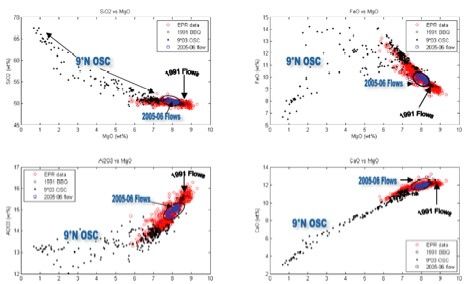Perfit
Eruptive Processes, Magmatic Evolution, Crustal Construction and Mantle Plumbing Derived from Temporal and Spatial Variations in Lava Compositions from the 8° - 10° N East Pacific Rise (EPR)
M.R. Perfit¹*, D.J. Fornari², W.I. Ridley³, K. Sims², D. Wanless¹, A. Goss¹, K. Rubin⁴, G. Kamenov¹, S.A. Soule², E. Klein⁵, S. White⁶, C. Waters², & P. Michael⁷
Corresponding author: mperfit@ufl.edu
¹Department of Geological Sciences, University of Florida*, Gainesville, FL 32611
²Woods Hole Oceanographic Institution, Woods Hole, MA 02543
³USGS, Denver, CO 80207
⁴SOEST – University of Hawaii, Honolulu, HI, 96822
⁵Duke University, Durham, NC 27708
⁶University of South Carolina, Columbia, SC 29208
⁷The University of Tulsa, Tulsa, OK 74104
Abstract:
Detailed mapping, sampling, and geochemical analyses (including major and trace elements, isotopes, and volatiles) of over 1600 EPR lavas collected from on- and off-axis from the Siqueiros Transform at ~8°N to the Clipperton Transform at ~10°N, including the 9°N OSC, have been used to investigate melting and melt focusing processes in the mantle, evolution of melt in the sub-crustal mush zone and overlaying melt sill, vertical and lateral transport of magma from the melt sill through dikes, processes and timing of eruptions on the surface, and hydrothermal circulation patterns. Previous studies of lavas (>1200) and gabbroic xenoliths from the 9° 26’N to 10° N region serve as excellent foundations upon which recent R2K investigations of the 2005-2006 eruption around the 9° 50’ bulls eye have been made (see Goss et al., this volume). Of particular significance are the documentation of changes in lava composition that have occurred since the 1991-92 eruption at the 9° 50’ BBQ eruption site and the remarkable range of lava compositions that recovered at the 9°N OSC compared to lavas to the north (see Figure 1 and Wanless et al., this volume).
Geochemical analyses of lavas from the 2005-06 eruption collected from on- and off-axis indicate that although they were derived from the same mantle source as the 1991-92 lavas, they are on average slightly more differentiated and chemically heterogeneous (Figure 1). Such short-term changes in chemistry provide information on the temporal and spatial aspects of MOR plumbing systems that previously have not been possible to obtain.
Mapping and sampling done with ROV Jason II, TowCam and DSL-120A during early 2007 at 9°N allowed us to examine the relationship between the spatial distribution of melt at depth, the loci of recent magmatism, and the composition of eruptive products by integrating geophysical data with our petrologic data. No evidence of recent eruptions overlying either the plunging melt sill beneath the southern portion of the East Limb or the melt sill underlying the West Limb was found. However, west of the northern portion of the East Limb, where seismic studies image a wide off-axis melt sill, the existence of young looking lavas and eruptive fissures suggests relatively recent volcanism associated with the off-axis melt sill. Lavas recovered from the OSC exhibit remarkable compositional diversity, ranging from typical MORB to dacite: 33% of OSC lavas have SiO2 > 52 wt. %, compared to ~3% for ocean ridge basalts worldwide (Figure 1). Petrographic data and trace elements variations reveal complex spatial systematics suggesting variations in source composition, extents and depths of melting, and crustal evolution.
Contributions to Integration and Synthesis:
These geologic, petrologic and geochemical data sets represent the most complete and extensive integrated studies completed on any MOR to date. Integration with mapping and dating studies is largely completed for the bulls eye region but more should be done to integrate hydrothermal and geophysical data (magnetics, seismicity, MC seismic reflection, compliance) in this area to better understand the 3D and temporal development of mid-ocean ridges. Additionally, these results could be compared to data from the Lamont Seamounts to provide insights into near-axis seamount formation. Significantly more data integration could be done south of ~ 9° 27’ N particularly in the 9°N OSC area where previous geophysical work (3D seisimic) provides detailed information on the distribution of melt in the upper mantle and crust. Although some sampling has been done south of the OSC, more detailed studies need to be completed before significant advances could be made by data integration.
Figures:
Figure 1. Major element variation diagrams of glasses from the 9°-10°N region of the EPR highlighting the ranges of compositions from the more than 1200 basalts from the 9° 30’ to 10° N EPR (open symbols) and the extreme differentiation in lavas from the 9° 03’ N OSC (crosses). Also shown are the distinct differences in the compositions of lavas erupted in 1991 (BBQ flow) versus those erupted in 2005-2006 in the 9° 50’ axial region. Perfit_fig1.jpg

